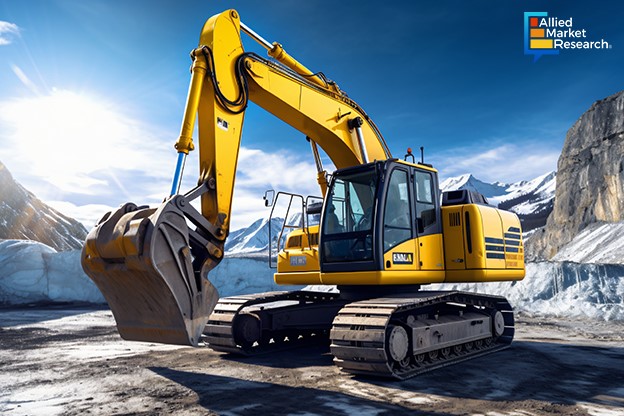Large Excavators: Which Technologies Should Construction Equipment Manufacturers Invest in to Stay Ahead in the Industry?

22 Apr
2024
Key takeaways
- Introduction
- Technological advancements in the sector
- Major product launches in the domain
Developing countries like India, China, Mexico, and Indonesia are increasingly investing in infrastructure development to drive their GDP growth rate and create jobs for their citizens. As a result, the industries involved in construction and infrastructure development have a huge demand for equipment and machinery like large excavators. These excavators, in alignment with the evolving construction sector, have witnessed huge technological transformation in the past few years.
Analyzing the innovative technologies that have changed the nature of large excavators
Excavators are large machinery used for earth digging, mining, and other construction-related activities; excavators weighing more than 45 tons are generally considered large excavators as per international standards. These excavators, due to their huge size and multiple functionalities, are hard to operate with precision. Hence, several technologies are being incorporated with these excavators to enhance their efficiency.
One such technology is 2D-grade control technology; this technology is designed to help excavator operators control the height and slope of the ditch that is to be created. For this, the excavator is fitted with angle sensors, laser catchers, and dual-axis sensors to achieve a specified digging depth. 2D-grade control is specifically employed in excavators which are employed for tight tolerance applications such as slope grading, plane flatting, and slope deepening.
While 2D-grade control is becoming popular, engineers and researchers have started developing and testing 3D-grade control technology. This technology is especially used for complex construction projects where higher precision is required such as bridge headers, dam constructions, reclamation projects, and embankments. This technology has also been proven to be fuel-efficient and has better safety mechanisms in place.
Semi-autonomous digging and grading technology is another such technology that is being used to simplify the earth's digging and mining operations. This technology involves the use of machine position sensors which help define different parameters like slope gradient and operator-defined depth. Once these parameters are specifically defined, the boom and stick movements for cutting become more precise and accurate. Once the desired depth is reached, the machine position sensors send a signal to automatically stop the excavation.
Understanding the evolving dynamics of the large excavator industry
As said earlier, developing countries across the globe are experiencing a growth in demand for large excavators to support the increasing number of infrastructure projects. The large excavator industry is predicted to get a major boost due to the rise in demand in these countries; for instance, the industry is anticipated to rise at a CAGR of 4.3% in the 2023-2032 period. Apart from this factor, technological advancements such as Artificial Intelligence and IoT are estimated to open new avenues of growth in the sector. The growing population in these countries has increased the demand for residential and commercial spaces which is projected to play an important role in helping this domain flourish.
The large excavator domain is a highly dynamic one with multinational companies such as Caterpillar Inc., XCMG Construction Machinery Co., Ltd., Hyundai Infracore Co., Ltd., and AB Volvo competing for dominance. These companies have launched several products that have also led to a surge in the growth rate of the sector. For instance, in May 2020, SANY, a major industrial construction manufacturing industry, announced the expansion of its product portfolio by launching three large excavators- SY870H, SY980H, and SY1250H. With a weight of 78.6 tons, 95.8 tons, and 125 tons respectively, these large excavators have been designed for fuel-efficient and reliable earth-digging activities. The launch of these three excavators is anticipated to increase the footprint of SANY in this sector significantly.
Similarly, in December 2023, Tata Hitachi, a construction equipment and machinery manufacturer, announced the launch of the first ‘Made in India’ electric excavator. The company released a statement after the launch stating that the product launch was in line with the company’s policy of environmental sustainability and commitment to creating a greener planet. The launch of an electric excavator marks the beginning of an electric revolution in the large excavator sector also, which is estimated to transform the industry in the years to come. This product launch is, thus, projected to help the company as well as the domain substantially in the near future.
To sum it up, the growing number of infrastructure projects and the rising demand for residential and commercial spaces in developing countries like Mexico and India are estimated to be the primary growth driver of the large excavator industry. The increasing incorporation of technologies such as 2D and 3D grade control and semi-autonomous digging and grading are predicted to offer numerous opportunities for the industry’s growth. The launch of several innovative products from multinational conglomerates will further expand the scope of this sector in the next few years.
For tips and suggestions on how businesses must capitalize on the opportunities offered by the industry, feel free to contact us.

Akhilesh Prabhugaonkar
Author's Bio- Akhilesh Prabhugaonkar holds a bachelor’s degree in Electronics Engineering from the reputed Vishwakarma Institute of Technology. He has a special interest in the fields of forensics, world history, international relations and foreign policy, sports, agriculture, astronomy, security, and oceanography. An ardent bibliophile and melophile, Akhilesh loves to write on topics of his interest and various other societal issues. This love for writing made him enter the professional world of content writing and pursue his career in this direction.
Rigid Plastic Packaging: Analyzing the Changing Nature of the Industry with Growing Focus on Environmental Sustainability
Avenue: Entire Library membership of Allied Market Research Reports at your disposal
- Avenue is an innovative subscription-based online report database.
- Avail an online access to the entire library of syndicated reports on more than 2,000 niche industries and company profiles on more than 12,000 firms across 11 domains.
- A cost-effective model tailored for entrepreneurs, investors, and students & researchers at universities.
- Request customizations, suggest new reports, and avail analyst support as per your requirements.
- Get an access to the library of reports at any time from any device and anywhere.
Related Post
-
How are Submarine Cables Transforming Global Connectivity with Enhanced User Experience?
-
Endoscopy Procedures: Transformations in Techniques and Applications
-
AI-Powered Video Analytics: How the Product Actually Works for enterprises
-
Painting Robots: Transforming Precision Coating and Creative Applications
-
Innovations in Pharmacovigilance Systems Advancing Patient Safety
-
Understanding Edge Security: Keeping Data Safe Near the Source
-
Exploring the Use and Advancements of 3D Laser Scanners in Professional Applications
-
Reinforcing Industrial Controls with Smarter Tools and Training








